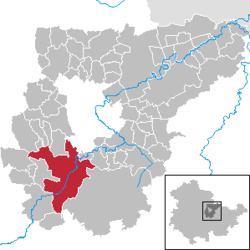Bad Berka
| Bad Berka | ||
|---|---|---|
|
| ||
| ||
 Bad Berka | ||
Location of Bad Berka within Weimarer Land district  | ||
| Coordinates: 50°54′0″N 11°16′51″E / 50.90000°N 11.28083°ECoordinates: 50°54′0″N 11°16′51″E / 50.90000°N 11.28083°E | ||
| Country | Germany | |
| State | Thuringia | |
| District | Weimarer Land | |
| Government | ||
| • Mayor | Thomas Liebetrau | |
| Area | ||
| • Total | 55.27 km2 (21.34 sq mi) | |
| Population (2015-12-31)[1] | ||
| • Total | 7,534 | |
| • Density | 140/km2 (350/sq mi) | |
| Time zone | CET/CEST (UTC+1/+2) | |
| Postal codes | 99438 | |
| Dialling codes | 036458 | |
| Vehicle registration | AP | |
| Website | Bad Berka | |
Bad Berka (![]() ) is a German city, situated in the south of Weimar region in the state of Thuringia. With its almost 8,000 inhabitants Bad Berka is the second biggest city in Weimarer Land district (after Apolda, 23,000). The river flowing through the city, which is embedded in new red sandstone, is called Ilm.
) is a German city, situated in the south of Weimar region in the state of Thuringia. With its almost 8,000 inhabitants Bad Berka is the second biggest city in Weimarer Land district (after Apolda, 23,000). The river flowing through the city, which is embedded in new red sandstone, is called Ilm.
Bad Berka is a spa town with an iron-rich spring and Kneipp facilities. In 2002 the award of "State Recognised Spa with Mineral Spring Health Facility" was given to the city. In order to treat tuberculosis, a clinic was erected in 1952. This was the beginning of the main economic sector of the city. Bad Berka's Zentralklinik has since gained a reputation as a center of medicinal expertise far beyond the boundaries of Germany. Its foundation can be traced back to 1898. In addition, there was a rehabilitation clinic built after the fall of the Berlin Wall. The "Median-Klinik" consists of two buildings, which were opened in 1994 and 1997.
Because of its vicinity to the cultural capital Weimar and association with numerous historical figures, Bad Berka is also popular among tourists. Between 1812 and 1828 Goethe visited his friend Heinrich Friedrich Schütz several times. He was also involved in the plans of the spa. Therefore, Bad Barka is called "Das Goethebad im Grünen" (Goethe spa in greenery), as well. Bad Berka is surrounded by spruce and beech forest.
Other bigger cities in the vicinity are Jena (20 km (12 mi) north-east), Erfurt (20 km (12 mi) north-west) and Weimar (12 km (7 mi) north).
History
In 1251, a Cistercian nunnery was founded at Bad Berka, and the sulphur bath spa was established in 1813.
Within the German Empire (1871-1918), Bad Berka was part of the Grand Duchy of Saxe-Weimar-Eisenach.
In 1945, bombing targets of the Oil Campaign of World War II were the Bad Berka oil plant,[2] oil storage,[3] and underground forced labor plant.[4]
The annual Party.San Open Air music festival was first held in 1996.
Sons and daughters of the town
- Otto Fries (1849-1905), politician National Liberal Party (Germany), member of Reichstag
- Hugo Günther (1891-1954), party functionary (SPD/KPD/KPO/SED) and insurance director
- Hans Carl Nipperdey (1895-1968), law professor, first president of the Federal Labour Court
- Hartmut Griesmayr (born 1945), screenwriter and director
Town twinning
Bad Berka is twinned with:
 Żabno, Poland
Żabno, Poland
| Wikimedia Commons has media related to Bad Berka. |
References
- ↑ "Bevölkerung der Gemeinden, Gemeinschaftsfreie Gemeinde, erfüllende/beauftragende Gemeinden, Verwaltungsgemeinschaft/Mitgliedsgemeinden in Thüringen". Thüringer Landesamt für Statistik (in German). July 2016.
- ↑ McKillop, Jack. "March 1945". Combat Chronology of the USAAF. Retrieved 7 April 2009.
- ↑ "2nd Lt. Donald A. Jones". 100th Bomb Group (Heavy): The Bloody Hundredth. 100THBG.COM. Retrieved 7 April 2009.
- ↑ Aroneanu, Eugène; Whissen, Thomas (1996). Inside the Concentration Camps. Greenwood Publishing Group. p. 148. ISBN 978-0-275-95446-8. Retrieved 7 April 2009.
